Back to The Discus.com Learning Center
Back to The Discus.com Learning Center
Before we get into the different kinds of filters we should clearly understand the purpose of any filtering system. Basically a filter does one of three things. 1. It removes solids from the water. 2. It provides a surface area for bacterial growth needed to change chemical compounds from one to another. 3. It can be used to induce chemical compounds to the water you are filtering as well; this in turn will alter the chemical nature of the water in many different ways plus it can aid in increasing the oxygen content of the water by rippling the surface area on its discharge.
Filters do one or all the above things. It depends upon the design of the filter and what you wish it to do.
It would be very helpful to you, the reader, to read the articles on Discus Page Holland with the titles “Nature’s Wonders 1 through 4”. These explain in great detail just what bacterial filtration is and how it works.
DIFFERENT TYPES OF FILTERS
FOR THE HOME AQUARIUM
AND HOW THEY WORK.
Let us first take a look at the good old under-gravel filter, this one has been around a very long time and has earned the name.” The filthy demon filter. It generally is the first mistake a new comer to the hobby makes, and the favorite the L.F.S. ( Local Fish Store) likes to sell you. I think the reason this is done is that they just don’t know any better, and 2. It is a high profit item for them.
The principle way this filter works is to place it in the bottom of your tank, and cover it with gravel. Then either with the use of water flow or airflow you cause the water in the tank to flow through it. In theory this sounds good. But in actual practice it leaves a lot to be desired and in the end can wind up being worse then no filter at all. The water passing though the gravel then allows certain types of bacteria to grow on the surface area of the gravel. In theory this works pretty good, but in practice, it becomes a nightmare for the discus hobbyist.
It does not take long before the pores though which the water flows start to clog up with left over food and fecal matter from the fish. This turns the filter into a big filth collector. This in turn invites all kinds of harmful results. Diseases find a great place to grow and multiply plus this type of environment is favorable to a great many parasites, and allows the build up of harmful chemical compounds as well.
Anyone who has used such a filter for a few months and then had to take the tank apart will know by the rotten egg smell that something is not right in such a setup.
A lot of new hobbyist get started with this type of filter, and are told to keep the gravel clean buy vacuuming the fecal matter and other solids out by washing the gravel as they make water changes. Again in theory this sounds good, but is not effective or practical for long term use. All kinds of harmful substances are gathered under the filter plate and these are not removed that easily. Some with say use reverse flow power pumps to flush the gravel from bottom to top. Again this sounds good but rarely works well. No the best way to handle this type of filter is to not get involved with it. Just let the uninformed learn the hard way. Remember this filter is deadly to discus in the long run. And the longer it is in operation the worse the matter becomes.
THE DIATOMACEOUS EARTH FILTER.
This filter is rarely used in the average fish room. But it offers some very special advantages for fish shows or if you need to filter the water to what is often called a shine.
Diatomaceous earth is a powdery natural material that can be found in different grades of pureness. It was formed almost entirely from the skeletons of diatoms, which lived in the seas, and their skeletons were deposited on the sea floor during the Cenozoic era. The material used in filters is made up almost entirely of silicon dioxide or silica. Because it is so fine it is often used in filtering chemicals and in special applications where purity is required in the final product.
This filter offers the advantage of removing extremely small particles from water, in fact it is said to polish water when used in fish shows, it makes the water appear to sparkle or shine. Most bacteria are filtered out of water using this system.
The disadvantages however, in general, reduce its usefulness for long term use in the home aquarium. The pores, which the water flows through, are so small that they clog quickly and the water flow is reduced below acceptable levels. This requires frequent cleaning and replacement of the filtering material: the D.E. earth. While this is not very expensive it becomes a somewhat nasty chore and must be done all to often for most uses.
I would not consider these types of filter a biological unit, in that it does not operate through the use of a bacterial build up on the filtering media. It should always be considered a filter to remove solids only and then on short-term bases between cleaning and recharging with D.E.
CANISTER FILTERS
Now we will look at one of the most useful of all the powered filters. This filter offers many advantages and a few disadvantages as well. But over all it will always play an important part in tropical fish keeping aquariums.
This filter works within a closed container that is pressurized by the internal water pump that causes the water to be forced through whatever media is used. Lots of different things can be used within this type of filter to treat the water playing though it. In addition it generally can remain in the system long enough to be considered a low-grade biological filter system as well.
One of the limitations is that the capacity is fairly small and it can not hold a lot of desirable media at one time, such as peat moss. Most of the canister filters are used with activated carbon and some type of floss to catch and hold solids as the water is pumped through it. However they do allow a very large water flow when maintained properly.
When shopping for this type of filter you will find a large number offered for sale by several different companies and they come with a wide selection of sizes and water treating capacity. I have in the past used selected models made by most companies and found them all to be about the same as far as dependability is concerned. Just bare in mind the different features that each will perform based on size and power rating.
POWER FILTERS
When we speak of power filters of course it includes the canister filters but generally when you hear the term power filter you will find people are referring to a filter that is an open system filter, in that it is not operated within a sealed container and is not pressurized.
These types of filters are found in a very wide range of configurations and sold by a large number of manufacturers, each offers it’s own features and most are rated in gallons per hour of water exchange. Do not confuse the powered types with the air operated ones which will be explained as we go along in considering all the different types of filters.
“In the beginning there was dirty water on the face of the aquarium,” and someone said, let there be filters! And it became so. And everyone keeping fish said this is good. Now let there be different kinds and it came to pass there were many made. Some good and some not so good. And the voice said ” Gees, they are never satisfied “.
When the outside box filter came along it was powered by air flowing through an up lift tube that pushed the water into the box as the air escaped to the top of the water. These filters are still in the hobby and are still sold in great numbers worldwide. They for the most part are designed to hang on the outside of the aquarium and air pump water back over the edge of the tank after it flows into the box via a siphon tube. The water is passed though some kind of media before being returned to the tank.
In a way this is still a power filter by definition since is it powered by airflow. But as now currently applied when you speak of a power filter, this refers to one that is powered by an electric motor, which operates a pump to lift or send the water into the filter box. You will find quite a few arrangements of the principle when shopping for filters. All kinds of cute sales gimmicks are added to increase your desire to own the best of the best of the best. Example: cute little wheels that spin around as the water flows over them. While I am sure this does provide additional surface areas for the bacteria to grow on I would not bet the family farm that it works as well as advertised and the add on cost should be considered when comparing effectiveness of the filter and what you expect it to do for the tank. Just because a manufactured item makes super claims about a product does not make it a true statement of fact.
LET’S REVIEW A BIT
Just how does a filter work, and what are the most important features we should look for in buying or even building our own?
Other than the removal of solids from the water, the filter should be designed so that it offers the largest surface area possible for nitrifying bacteria to attach themselves to for they are the basic working staff or work horses of the biological filter.
When you study and ask questions about these bacteria you will find that for every question answered two more questions will arise as a result. For these are truly amazing organisms. And how they perform in the filter depends upon its design and the use you the hobbyist make of it. Once again for a more detailed explanation I refer you to the articles “Nature’s Wonders 1 through 4” located on the Discus Page Holland web site.
CENTRALIZED FILTER SYSTEMS.
This type of filter offers the hobbyist who keeps multiple tanks the advantages of using one or more central filtering systems that provides proper filtration for a group of tanks. A system of this kind can be designed with adjustable flow rates to each tank independently. A central filter provides a larger volume of water though one set of media. And of course if the system is properly designed each tank can be removed from the system through a set of valves without interrupting the flow to the other tanks in the system.
There are advantages and disadvantages to be considered when using this type of system. The water in the central system is common to all tanks operating on that system. So one of the advantages is perfect control of the water parameters in all the tanks at the same time. But this is off set by the fact that should disease enter the system all tanks and fish on the system are exposed to it. But once again should disease or parasites become a factor medication can be applied to all the tanks from the same system at an uniform and controlled rate.
Since the physical layout for each fish room is different almost no two such systems are the same. I have seen one central system operate as many as a hundred tanks or as few and three or four. It is amazing what can be done with the use of PVC pipe and fittings, and the skill required is within the reach of almost anyone.
Centralized systems can be designed in any number of ways some flow thorough a single media that the bacteria develop on under water others use what is known as the drip-dry method which is explained next.
WHAT IS DRIP DRY?
In this system the water to be filtered is dripped on to a very large surface area such as bio-balls or cinder rocks and the water first passes though a floss sheet to remove solids then flows as evenly as possible over the bio-balls or rock in such a way that the surface areas are constantly kept wet as the water passes by. This is generally done with a spinning wheel or spray bar of some type. The water then gravity falls into a return supply tank and is pump feed back to the tanks as filtered water. It should be kept in mind that for proper growth nitrifying bacteria require a large and dependable supply of oxygen. There are three basic bacterial groups that are at work in any filter other than one strictly designed to remove solids only. These bacteria are, Heterotrophic, Nitrosomonas and Nitrobacter types. In order to provide the best growing conditions sometimes-large volumes of air is force blown through the media as the water trickles by.
In either the submerged type or the drip type system the use of a constant drip system can be added. In my systems I have arranged it so that from a low pressure value 25% of my water is constantly being replace and the old water over flows through a drain to the waste line. I have found this to be the most effective way to provide the most desirable conditions to my tanks at all times. Everything is totally automatic in such a system.
SO WHAT ELSE IS OUT THERE AS FILTERS?
I think the above explains the most common types found in the aquarium hobby today with the advantages and some of the disadvantages pointed out. But I must remind you that there are many more of a chemical nature used in other applications that just might be adaptable to the aquarium. And now last but not least, there are two other types to consider.
SAND FILTER.
In this type of filter the water is forced by a pump to flow through fine particles of sand which keeps them in a flowing state at all times. This system is not new but is new to the aquarium hobby so to speak. It has only recently been adapted to small-scale use in the home aquarium. When you can locate and buy one that works well as they are designed to do this type of filter offers a very large surface area for bacteria to grow on and therefore has many advantages in a small size with a low cost of operation. The problem arises in that they tend to clog badly and should the sand stop flowing as required the bacteria quickly die for a lack of oxygen and this in turn presents a deadly problem to your fish in quick order. One other problem I have found with these units is that all I have tested tend to blow some sand into the tank and this is not a desirable feature. Now we move on to what I consider to be the ideal filter for the use in a single tank arrangement, and even should be added to individual tanks on a central system.
THE SPONGE RUBBER FILTER.
I have used these filters for years, in the discus hatchery they offer more advantages and fewer disadvantages than just about any arrangement I can think of.
These filters are found now days in just about every pet store or aquarium shop. They can be seen in all sizes and arrangements from a single sponge to double or even triple sponge configurations.
The operation of this type of filter is simple and direct. The water is drawn through the sponge either by air flow or a powered pump. In the most common packages it is designed to operate much the same way the out side box filter works, air is released deep in a plastic tube centered in the sponge that has wholes positioned in such a way that water flows through these holes and through the sponge and is lifted upward with the flow of air within the tube. Of course a much greater water turn over rate can occur if a power head is use to forcefully draw the water though the system.
One of the great advantages is the simplicity of the entire arrangement. Another advantage is ease of cleaning and replacement. Then when you consider that very small fry are protected since they can not be sucked into the filter under such an arrangement you have almost a perfect filter. The surface area on a sponge is very large when it is designed right. I generally keep two or more sponge filters going in each tank so that they can be removed for cleaning without a lost of filtration. Cleaning is very easy and simple you just raise the filters in running water that is near the same temperature as that of the tank. A few squeezes in warm running water and you can place the sponge back in the tank ready for operation.
One other advantage I have noticed is that when discus have fry in the tank and are side feeding them the fry will gather around the dark sponge filter and peck at any food found there. This is handy when you start feeding newly hatched baby brine shrimp which are drawn to the sponge surface.
So there you have an over-view of filters. Enjoy their use in the hobby and don’t forget to keep any filter clean. Just because waste is outside the aquarium does not mean it is out of the system.


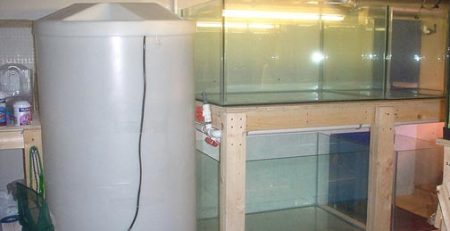
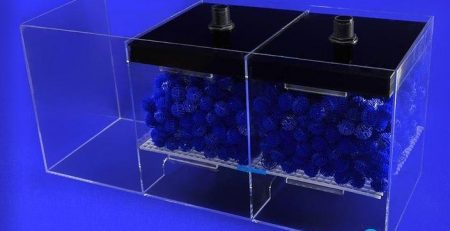

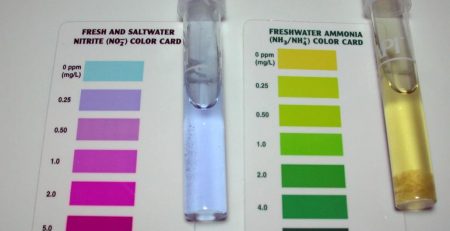
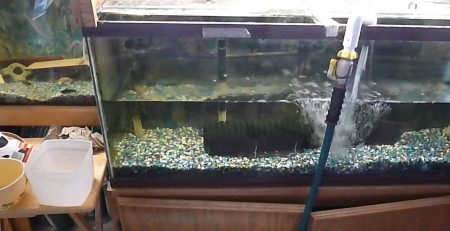
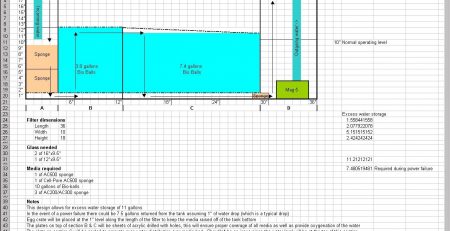

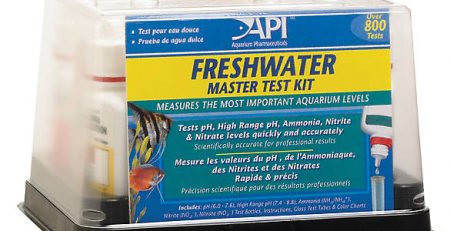
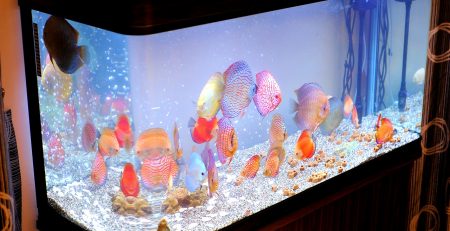
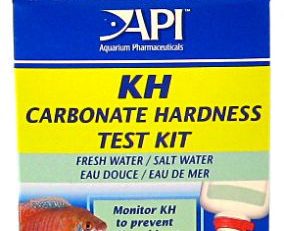
Leave a Reply
You must be logged in to post a comment.